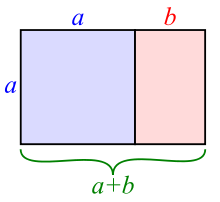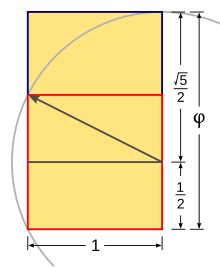
Back مستطيل ذهبي Arabic لاکێشەی زێڕین CKB Ылттăн тӳркĕтеслĕх CV Gyldent rektangel Danish Goldenes Rechteck German Ora ortangulo Esperanto Rectángulo dorado Spanish Kultainen suorakulmio Finnish Rectángulo dourado Galician स्वर्णिमायत Hindi

In geometry, a golden rectangle is a rectangle whose side lengths are in the golden ratio, , which is (the Greek letter phi), where is approximately 1.618.
Golden rectangles exhibit a special form of self-similarity: All rectangles created by adding a square to a side, or removing a square from an end, of a golden rectangle are golden rectangles as well.

Cite error: There are <ref group=lower-alpha> tags or {{efn}} templates on this page, but the references will not show without a {{reflist|group=lower-alpha}} template or {{notelist}} template (see the help page).
- ^ Posamentier, Alfred S.; Lehmann, Ingmar (2011). The Glorious Golden Ratio. Prometheus Books. p. 11. ISBN 9-781-61614-424-1.
© MMXXIII Rich X Search. We shall prevail. All rights reserved. Rich X Search


